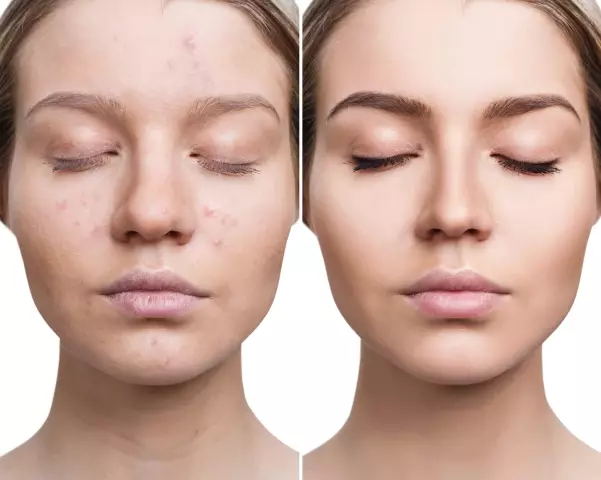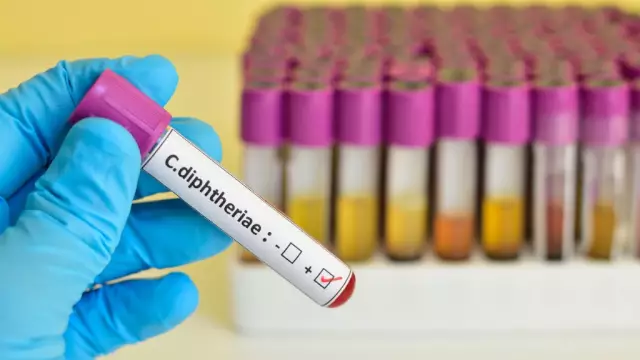- Author Rachel Wainwright [email protected].
- Public 2023-12-15 07:39.
- Last modified 2025-11-02 20:14.
Hypovitaminosis
The content of the article:
- Causes and risk factors
- Forms of the disease
- Symptoms
- Diagnostics
- Treatment
- Possible complications and consequences
- Forecast
- Prevention
Hypovitaminosis is a pathological condition caused by insufficient intake of one or more vitamins into the body.

Hypovitaminosis occurs when there is insufficient intake of vitamins in the body
Causes and risk factors
For each type of hypovitaminosis, there are specific causes. At the same time, there are a number of common factors, the impact of which can lead to the development of vitamin deficiency.
Hypovitaminosis conditions in modern people are caused by the predominance of refined foods (fine flour, polished cereals) in the diet with an insufficient content of vegetables, herbs, fruits and berries, and meat.
Inappropriate nutrition with a predominance of carbohydrates and a low content of animal proteins causes impaired absorption of a number of vitamins from the intestines during their normal intake into the body.
With prolonged heat treatment, the bulk of vitamins is destroyed in food. Therefore, people who do not eat fresh vegetables and fruits are prone to hypovitaminosis.

In some diseases of the gastrointestinal tract, the absorption of vitamins worsens, which leads to hypovitaminosis
Vitamin deficiency is often observed in residents of northern regions, as well as in those who are engaged in hard physical labor or are subject to frequent stressful situations, which is associated with an increased need for vitamins in these categories of the population.
Other reasons for the development of hypovitaminosis:
- diseases of the gastrointestinal tract, as a result of which the absorption of vitamins worsens;
- long-term use of certain medications, including antibiotics;
- a sharp restriction of fats in the diet, which leads to insufficient intake of fat-soluble vitamins into the body.
Forms of the disease
Depending on the lack of a particular vitamin, there are:
- Hypovitaminosis A. It is caused by insufficient intake of animal fats, as well as by a number of infectious and somatic diseases (pathologies of the intestines, liver, thyroid gland).
- Hypovitaminosis B 1. More common in Asian countries. The most severe form is known as beriberi disease. It develops with prolonged consumption of raw fish, refined foods, as well as with certain diseases (alcoholism, diabetes mellitus, chronic enterocolitis).
- Hypovitaminosis B 2. Its appearance is caused by the insufficient content of dairy products and protein in the diet, the intake of acriquine derivatives, some diseases of the intestines, pancreas and liver.
- Hypovitaminosis B 3 (lack of niacin, or vitamin PP). It is observed in people predominantly eating corn. Other predisposing factors are bowel disease, long-term use of anti-tuberculosis drugs.
- Hypovitaminosis B 6. It occurs mainly in patients receiving anti-tuberculosis therapy or suffering from chronic bowel disease.
- Hypovitaminosis B 9 (lack of folic acid). The reasons for its appearance are alcoholism, systematic long-term heat treatment of food, chronic enterocolitis, bowel resection, long-term therapy with sulfonamides and (or) antibiotics.
- Hypovitaminosis B 12. It develops against the background of chronic diseases of the digestive system, resection of the intestine or stomach, helminthic invasions, alcoholism and insufficient animal protein in the diet.
- Hypovitaminosis C. It is observed most often, which is explained, first of all, by the rapid destruction of vitamin C during heat treatment of products or their long-term storage. The reason may also be an increase in the need for ascorbic acid (with infectious diseases, stressful situations, overwork, heavy mental or physical labor).
- Hypovitaminosis D. Usually observed in children living in the northern regions. This is due to the fact that the main part of vitamin D does not come from food, but is formed in the body under the influence of solar radiation. Another reason is poor nutrition with insufficient intake of phosphorus and calcium salts, animal fats.
- Hypovitaminosis K. It is caused by diseases of the intestine and hepatobiliary system, long-term therapy with anticoagulants or antibiotics, the predominant consumption of low-fat foods.

Signs of hypovitaminosis
Symptoms
Each vitamin performs a specific function in the human body, therefore, the lack of one or another vitamin is clinically manifested in different ways. However, there are a number of symptoms common to all hypovitaminosis conditions:
- drowsiness;
- weakness, increased fatigue;
- poor appetite;
- nausea;
- irritability.
In addition, the most common types of hypovitaminosis have a characteristic clinical picture.
Hypovitaminosis A is manifested by the following symptoms:
- increased fragility and hair loss;
- increased keratinization of the skin;
- violations of the correct color perception;
- night blindness (twilight vision disorder);
- turbidity and dryness of the cornea;
- eminences and whitish grooves on the nail plates;
- well-defined light spots on the skin around the mouth.
Hypovitaminosis C:
- bleeding gums;
- the appearance on the skin of bruises formed under the influence of minor mechanical influences;
- decreased immunity, manifested by susceptibility to infectious diseases.
Hypovitaminosis B 1 can occur in two forms:
- Dry - there are cramps in the calf muscles, violations of the sensitivity of the skin of the lower extremities.
- Edematous - edema appears and increases, shortness of breath develops.

Hypovitaminosis B 1 is manifested by edema and shortness of breath
Signs of hypovitaminosis B 3:
- diarrhea;
- an enlarged, bright crimson tongue;
- swollen red spots on the skin of the hands;
- rough, flaky, darkened skin.
Hypovitaminosis B 6 is manifested:
- cracks in the corners of the lips;
- peeling and dry lips;
- conjunctivitis;
- deterioration in color vision;
- dry skin;
- "Lacquer" tongue with imprints on the lateral surfaces of the teeth.

Cracks in the corners of the lips signal hypovitaminosis B 6
Lack of vitamin B 12 is characterized by:
- anemia;
- atrophic gastritis;
- changed gait;
- violation of the sensitivity of muscles and skin;
- the appearance of a purple rim around the cornea (which is associated with the proliferation of blood vessels).
Hypovitaminosis K is manifested by a deterioration in blood clotting (hypocoagulation), which leads to spontaneous nosebleeds, bruising on the skin, bleeding of the gums.
In clinical practice, an isolated deficiency of only one vitamin is extremely rare, since an insufficient intake of one vitamin always entails a violation of the absorption and (or) exchange of other vitamins. There are a number of signs that make it possible to suspect combined vitamin deficiency:
- dry skin with slight pityriasis peeling is characteristic of hypovitaminosis C and A;
- the appearance in natural folds of shiny skin areas with the presence of yellowish small scales is observed with a lack of B vitamins;
- hemorrhages in soft tissues, bleeding gums, spontaneous nasal bleeding accompany hypovitaminosis C, K and PP;
- the appearance of thickened skin over the joints, covered with small cracks, indicates hypovitaminosis B 3 and A;
- "Goose bumps" in the forearms, thighs and buttocks are observed with hypovitaminosis A, B 3 and C;
- icteric staining of the skin - with hypovitaminosis A and PP;
- the appearance of cracks in the corners of the lips is a sign of hypovitaminosis A and B 2;
- cyanotic coloration of the lips - a signal of hypovitaminosis C and B 3;
- an enlarged tongue with a changed bright color, the appearance of whitish scars in the area of the border of the mucous membrane of the oral cavity and the border of the lips are characteristic signs of hypovitaminosis B 1, B 3, B 12 and B 6;
- atrophic gingivitis, enlarged interdental papillae; bleeding and looseness of the gums are observed with hypovitaminosis B 3 and C.
Diagnostics
The diagnosis is suggested on the basis of the clinical picture and history data. To confirm the diagnosis, the content of the vitamin of interest in the blood is determined. In order to establish the cause that caused the development of hypovitaminosis, carry out:
- study of feces for helminth eggs;
- intragastric pH-metry;
- fibroesophagogastroduodenoscopy.

To determine what vitamin in the body is lacking, a blood test is performed
Treatment
Treatment consists in eliminating the cause of hypovitaminosis. With alimentary hypovitaminosis, that is, caused by insufficient intake of vitamins into the body, diet therapy is the main method. The diet is developed by a gastroenterologist, taking into account the needs of a particular patient. Meals should be varied, balanced in protein, fat and carbohydrate content. The diet must include berries, fruits, herbs, vegetables, easily digestible protein products.
If necessary, vitamin preparations are prescribed. The duration of the course and the dosage are set by the doctor.

Proper nutrition and vitamin intake is the basis for the treatment of hypovitaminosis
Possible complications and consequences
The progression of any form of hypovitaminosis can lead to the development of an extreme degree of vitamin deficiency in the human body - avitaminosis, which manifests itself as a serious disease (beriberi, pellagra, scurvy, etc.) with dysfunction of a number of organs.
Forecast
With timely treatment started, the prognosis is favorable.
Prevention
Prevention of hypovitaminosis consists in proper nutrition, balanced in all essential nutrients, with the obligatory inclusion of a sufficient amount of plant and animal products in the menu.
YouTube video related to the article:

Elena Minkina Doctor anesthesiologist-resuscitator About the author
Education: graduated from the Tashkent State Medical Institute, specializing in general medicine in 1991. Repeatedly passed refresher courses.
Work experience: anesthesiologist-resuscitator of the city maternity complex, resuscitator of the hemodialysis department.
The information is generalized and provided for informational purposes only. At the first sign of illness, see your doctor. Self-medication is hazardous to health!






